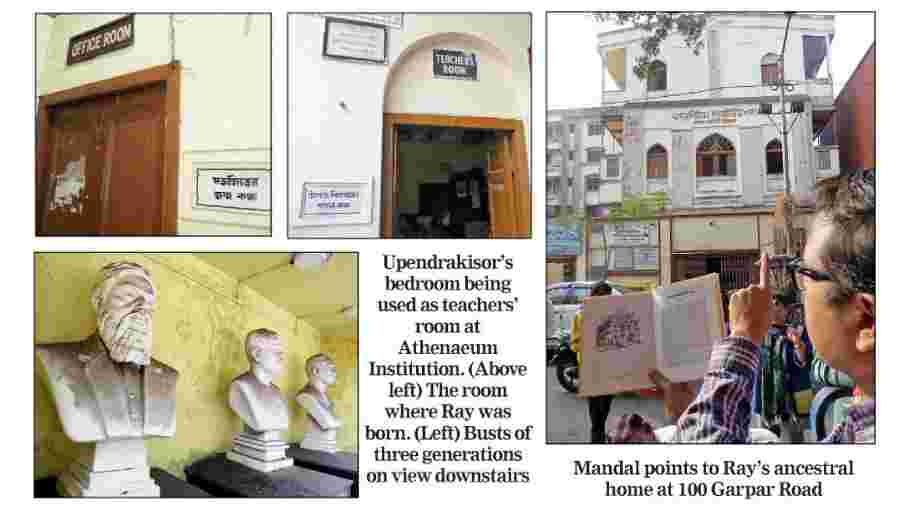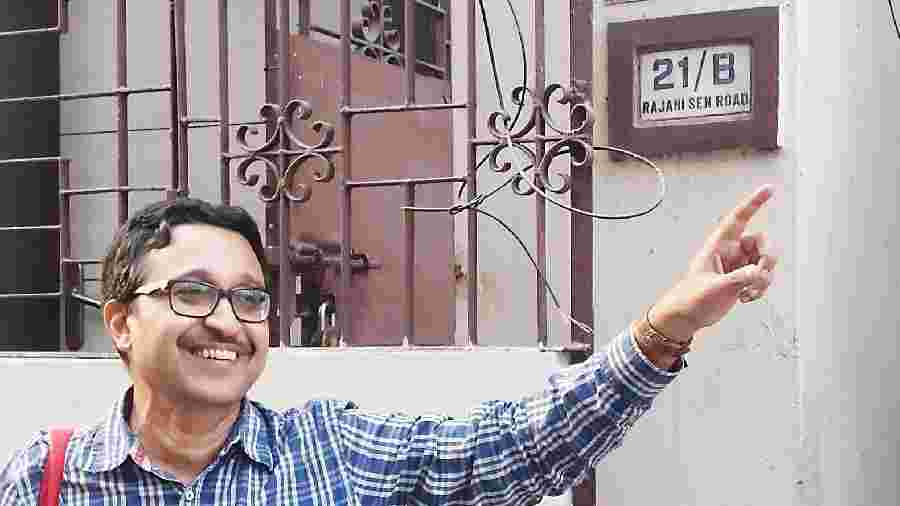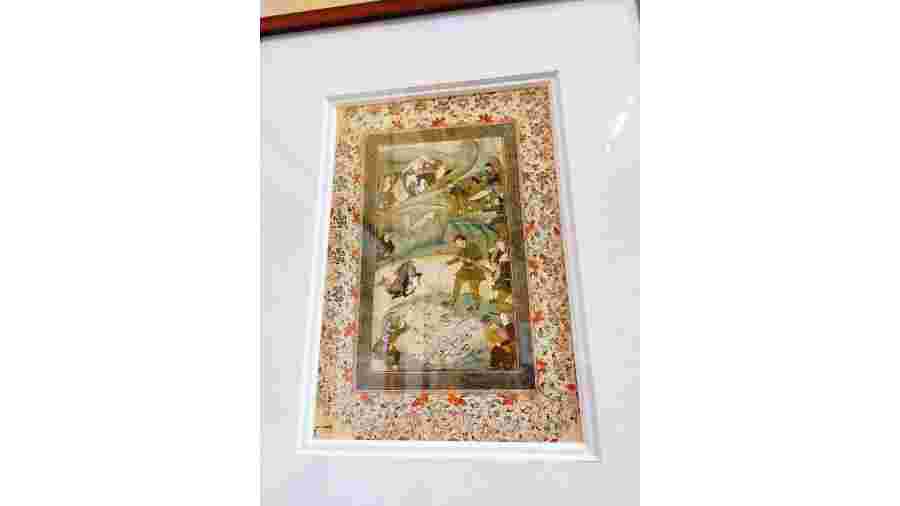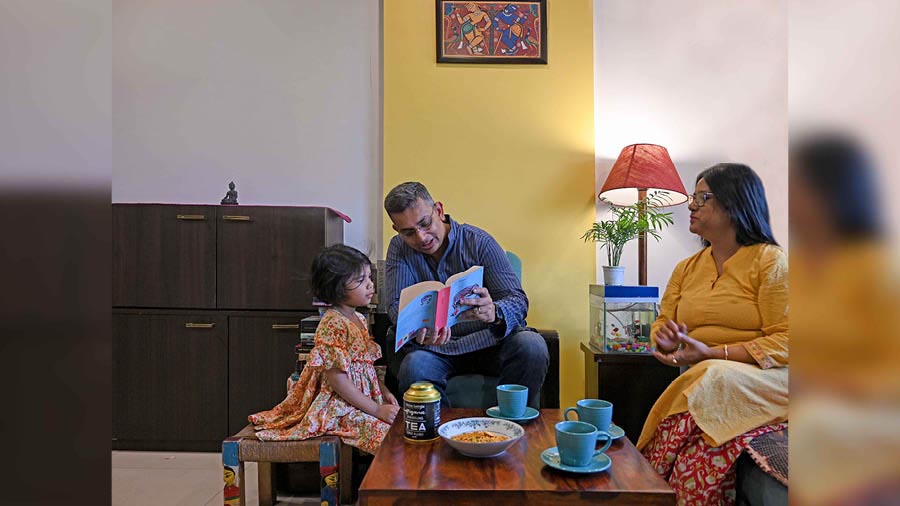A huddle had formed quite early in the morning on the pavement across the road in the Garpar locality in north Kolkata. Ayon Mandal, a resident of Alaktika Housing Complex in Action Area IID, was holding forth, quoting from a book in his hand. The building he was pointing to houses the school Athenaeum Institution. This is where Satyajit Ray was born on May 2, 1921.
The book in Mandal's hand was Jokhon Chhoto Chhilam, Ray’s autobiography.
Mandal, an IT professional cum Feluda addict, was leading a tour called Feluda The Nostalgia, commissioned by the heritage committee of the Bengal Chamber of Commerce and Industry which was taking a busload of Feluda fans from one point to another connecting the dots in the city's landscape that find mention in Ray's writings, both autobiographical and fictional.
The first stop of the day-long tour was 100 Garpar Road. The building was designed and built by Upendrakisor Raychaudhuri who started his own printing press there. The name U Ray & Sons is still cemented in Bengali letters at the top of the facade. That is where on the ground floor the then fledgling children’s magazine Sandesh would be printed. Upendrakishore and his son Sukumar also died here.
Mandal read out an excerpt from the book which carries an illustration of the building. “The press was on the ground floor. ‘To the west of our house,’ writes Ray, ‘was the deaf and dumb school and to the east was Athenaeum Institution.’” The school for the challenged, which predates the building, still exists while the institution has shifted to the building itself with the address 100A Garpar Road.
The Telegraph Salt Lake lingered behind the group to enter the building alone and on request, was taken around by a kind teacher of the school. Upendrakisor’s room is now the teachers’ room while Sukumar Roy’s room stands next to the room where Satyajit was born, each marked by a plaque.
Mandal, who, like Feluda, loves to explore lanes and bylanes on foot wherever he goes, has set up Walk Calcutta Walk, along with his friend Deep Bhattacharya, four years ago. “People travel to Jaisalmer, Puri, Nepal and even Hong Kong, and marvel at the connections of these places with Feluda’s adventures. But how many have bothered to check out the places in our city with direct links to Ray and his characters? That is what prompted us to set up the Feluda walk,” he told The Telegraph Salt Lake.
In this context, he quoted the short poem Rabindranath Tagore had scribbled in little Satyajit’s autograph book that Ray has quoted in his autobiography about traveling to far-off places but not venturing out to the neighbouring field to watch the marvel of a dewdrop on a blade of glass.
The Garpar building is doubly significant for Feluda fans in that not only was Ray born here but he also made this Lalmohan Ganguly aka Jatayu’s home. As for the school, Jatayu is said to have studied here, with Baikuntho Mullick, among others, as teacher whose doggerel verses he would break into from time to time.
Back on the bus, Mandal handed over chits of paper to each of the passengers, with a rhyme that carried the clues to a Feluda riddle. One significant clue was where the next stop was - Marble Palace — which tallied with the words “Malik Mullick-er marmarhormo”, as the house had been built by Rajendra Mullick, a merchant prince. The first word “gaayebonguri” made the wannabe sleuths consider the story Badshahi Angti. It helped that the story had a character “saap bichhe niye karbar jar”, as described in the rhyme, in Banabihari Sarkar.
In cracking the puzzle, the participants were made acquainted with an interesting trivia related to the history of Kolkata’s zoo. Wajid Ali Shah, the exiled nawab of Oudh and Mullick were friends and both had set up private zoos in Metiabruz and at Marble Palace respectively. The reference to Lucknow and the exiled Nawab of Oudh is there in the Feluda story where the sleuth hums a song, Jab chhod chale Lucknow nagari, that Banabihari identifies as composed by the Nawab and which Ray would later make Amjad Khan, playing the Nawab, hum in his film Shatranj ki Khiladi as well.
BNCCI officials had arranged with the Mullick family to allow participants to visit the zoo housed across the sprawling lawn. It is the country's first zoo that opened to the public. “Ray used to visit our house every month at one point as he was a friend of Mrigendro Mullick, who was a national level billiards player,” his grandson Sourendro Mullick told The Telegraph Salt Lake.



Eureka moment: Ayon Mandal, a resident of Alaktika Housing Complex, points to the house number that is closest to Feluda’s address. Pictures by Sudeshna Banerjee

A painting of Jahangir which were the solutions to a riddle that the group had to crack

A gold coin from Emperor Jahangir’s reign


Electric distribution boxes with graffiti on Feluda films marking Ray and Soumitra Chatterjee’s stay at 3 Lake Temple Road
Missing gold coin
En route to the next stop, the Indian Museum, Mandal served the second riddle that started with a reference to a Badshah, who was fond of hunting and getting his heroics sketched on canvas. There was mention of a theft of a piece from his set of money from a chest in “joler bajare”. The participants, now working together, much to Mandal’s amusement, toyed with the possibility of the second riddle dealing with Badshahi Angti like the first had been but soon discarded the thought.
Another Feluda adventure, Golapi Mukto Rahasya, came up briefly for consideration but was tossed aside. So they zeroed in on Jahangirer Swarnomudra. “It must be talking of a gold coin and it must be in the museum,” was the consensus and the team spread out in search of the Mughal gallery. The discovery came in two parts — first, a 16th century gouache on paper painting of Emperor Jehangir hunting deer and then a mohur carrying Jehangir's portrait, dated 1605-1628, displayed among several other silver pieces.
“But what is this joler bajare in the riddle, Ayon?” asked Rajdipta Biswas of Highland Willows, one of the participants. “Panihati. Remember that was where the mansion in Jehangirer Swarnamudra was?” he responded with a smile.
The delightfully worded clues, Mandal said, came from his book Sandhane Dhondhay Feluda, which is full of such riddles. “The rhymes have been composed by my uncle based on the riddles I created. The book’s title is taken from a riddle almost at the start of Ray’s Royal Bengal Rahasya, which starts with Buro hoy muro gachh…” he said.
The group lingered at the museum for a session with BNCCI heritage committee officials. Chairperson G.M. Kapur said there was more to a city's heritage than its built heritage and Feluda was as much a part of Kolkata as Sherlock Holmes is of London.
We stopped briefly at what is a pilgrimage for any admirer of Ray — his house at Bishop Lefroy Road, where he spent the last two decades of his life. Sandip Ray, his filmmaker son, came down to the courtyard to meet us and pose for pictures.
After lunch at the suitably chosen restaurant Bhooter Raja Dilo Bor, named and themed after the famous song from Goopy Gyne Bagha Byne, the team explored the south Kolkata connections.
“If Ray gave Jatayu the address where he spent his childhood, he situated Feluda in the neighbourhood where he spent the years when he made films like Pather Panchali, Parash Pathar, Aparajito, Jalsaghar and Apur Sansar, and even later till 1970 when he shifted to Bishop Lefroy Road,” said Mandal.
Getting off our bus at Menoka cinema, our first destination was 3 Lake Temple Road where Ray spent 11 years, from 1959 to 1970. The house seemed to be under repairs, giving out no clue about its link with one of Bengal’s foremost icons. Incidentally, Soumitra Chatterjee, Ray’s own Feluda, would stay on the same premises, a fact borne out by the artwork on the neighbouring electric distribution boxes paying tribute to both.
We explored the neighbourhood in search of the address that is as alive in a Feluda fan’s mental map as 221B Baker Street is to a Sherlock Holmes disciple — 21 Rajani Sen Road.
We find a two-storeyed house, numbered 20, but next to it is a multi-storeyed block of apartments, numbered 22B. Our hearts sank. There is no trace of house no. 21 bang opposite to it as well. So has the number fallen through the cracks of Time?
“Let's walk a bit further up,” suggested Mandal. By then, late in the afternoon, our sleuthing strength had dwindled to just six participants. But there was no dearth of energy in us. An excited yell from two of them, who were walking ahead, alerted us that all was not lost.
There they were, with Mandal, pointing triumphantly to the address plate — 21/B Rajani Sen Road. Feluda lives. Even if he has to share space with an orthopaedic clinic in the same building.
If Ray is turning 102, Feluda cannot remain 27 forever, right?

